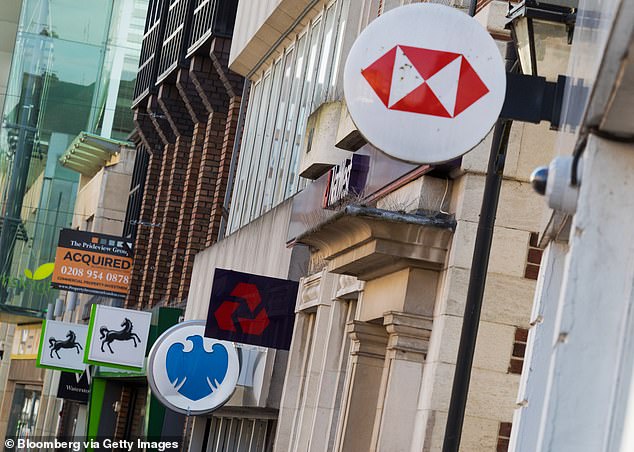Big banks shamed by rivals paying four times higher rates
>
The gap between High Street banks’ easily accessible savings rates and smaller rivals has widened dramatically over the past year.
Since December 2021, the Bank of England’s base rate has risen from 0.1 percent to 3.5 percent. But the big banks have not passed on most of the increases to savers and are therefore raking in the profits.
Experts expect the gap between base rates and rates at High Street banks to widen even further, with more Bank of England hikes forecast this year.

Restraint: Since December 2021, the Bank of England base rate has risen from 0.1% to 3.5%. But major banks have not passed on most of the increases to savers
Last year around this time, major banks mainly paid 0.01 percent on their popular easily accessible accounts. The best rate available elsewhere was 0.71 percent – a difference of 0.7 percentage points.
Currently, large banks pay a maximum of 0.65 percent, compared to 2.81 percent at other providers. It means that the difference has tripled to 2.16 points.
With some banks, the difference is even greater: they still pay only 0.5 percent on their easily accessible accounts.
None but one showed any signs of passing on even a fraction of last month’s 0.5 point Bank of England rate hike. That one bank, Santander, raised its Everyday Saver easy-access rate by just 0.15 point to 0.55 percent.
Newer banks and building societies pay much more.
Online, Al Rayan pays 2.81 percent and Cynergy 2.75 percent.
On the high street, Marsden BS pays 2.75 per cent, while more available is the 2.55 per cent that Yorkshire BS will pay on its Access Saver Plus 7 from 17 January.
Experts fear that many savers do not know how little they earn.
Banks must tell you when they will reduce your rate if you have £100 or more in your account.
But there’s no such rule that says they have to let you know when they increase their rate – or by how much. So they can get away with short change savers without telling them.
Anna Bowes of Savings Champion says: ‘Many savers assume their High Street bank will look after them.
But that’s not the case with most savings accounts. The difference between what they pay and what other providers pay can be significant.’
She adds: “This gap will widen as the Bank of England’s key interest rates are expected to rise again this year. Every time that happens, the major banks benefit from savers by not passing on interest rate rises.’
Easily accessible accounts are the most popular savings product.
The latest figures from UK Finance, the banking sector’s trade body, show that there are £913bn in instant access accounts at the largest banks. These include Barclays, Lloyds, Halifax, HSBC, NatWest, RBS, Santander, TSB and Virgin Money.
Barclays passed on just 0.49 points of the 3.4 point increase in base rates over the past 13 months.


Profit boom: Experts expect the gap between base rates and rates at High Street banks to widen further, with more Bank of England hikes forecast this year
This is the same for the Lloyds Standard Saver and Lloyds Easy Access. Savers with these accounts earn a miserly 0.5 per cent – or £50 interest per annum on every £10,000. On a top paying 2.75 per cent bill you can earn £275 – or £225 more.
NatWest Instant Saver and RBS Instant Saver are also up just 0.49 points, paying out 0.5 per cent on credits up to £25,000.
Those with larger balances fare slightly better, rising 1.24 points to 1.25 per cent on £25,000 balances.
However, that is still less than half the figure you can earn elsewhere.
Savers in Santander Everyday, Halifax Everyday and Halifax Instant Saver accounts also saw a dismal 0.54 percentage point increase to reach 0.55 percent.
HSBC increased its Flexible Saver to just 0.65 percent, up 0.64 points, while TSB Easy Saver now pays 0.6 percent.
Virgin Money has not increased its Everyday Saver at all in the past year and is still paying out 0.25 per cent.
Sarah Coles, senior personal finance analyst at Hargreaves Lansdown, says: ‘High Street banks are spectacularly disappointing life partners.
“If you give them your unwavering loyalty for decades, you might assume they’re giving something meaningful in return. But when it comes to our savings, they have little to offer.’
She adds: ‘Almost half of the people don’t bother to look for a savings account. They simply open one with their checking account holder, which is a terribly expensive mistake.
“Their High Street bills have increased slightly over the past year, but most open-to-all accounts still pay 0.5 per cent or less, which is an insult to die-hard savers.”
Major banks do offer some top rates, but they often come with a catch, so you’ll need to read the fine print carefully.
You can incur penalties if you withdraw money from your account, and the rate is often only available on a small balance.
The highest is Barclays’ Rainy Day Saver at 5.12 percent. But it’s only paid on balances up to £5,000, and no interest is paid on extra money at all.
The new Santander Edge pays 4 per cent on up to £4,000, including fees and cashback.
HSBC pays 3 per cent on balances up to £10,000 on its easily accessible online Bonus Saver. But the rate drops to 0.65 percent each month you withdraw.
Sy.morris@dailymail.co.uk
Some links in this article may be affiliate links. If you click on it, we may earn a small commission. That helps us fund This Is Money and use it for free. We do not write articles to promote products. We do not allow any commercial relationship to compromise our editorial independence.
